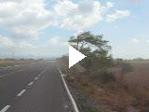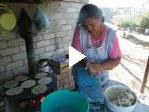Leaving San Cristobal de las Casas, I biked with Gregg and Brooks for one more day. We climbed over the mountains, and then descended to the east, where a thick green rainforest grew up around the road. The language changed, rendering useless our tiny Tsotsil vocabulary (‘hello’ ‘goodbye’ ‘you are very pretty’ ‘I do not want to buy that’). I also did not feel comfortable interacting with the locals. Passing one house, a young child yelled ‘gringo!’ stuck out his hand and yelled ‘da me un peso,’ or give me a peso. We arrived in the town of Ocosingo and we were advised the road ahead was unsafe in the afternoon or night. A car made a few passes by the main plaza, where we were seated, and each time a teenager in the car leaned out and yelled ‘un peso,’ more to taunt us than to ask for a peso. I did not ask if there was a fire station and went straight to a cheap hotel that I split with Gregg and Brooks.
The following morning, as I was planning to ride farther that day, I left at dawn while Gregg and Brooks were still asleep. I biked 30 miles to the town of Agua Azul where I played for 4 hours in waterfalls and clean cool pools. A poorly translated sign (middle photo) encouraged swimming, and I obeyed.
After 4 hours, I was surprised Gregg and Brooks had not arrived. I returned to the main road to continue on, and I asked a police officer if he had seen my friends.
A few miles short of Agua Azul, while Gregg and Brooks were slowly climbing a hill, two men with machetes and masks jumped out of the forest. They demanded all of Gregg and Brooks’ stuff. They grabbed at their panniers, yanked hard, shaking the bikes Gregg and Brooks were still on, but were not able to get the bags off the bike. Growing frustrated, they hit Gregg and Brooks with the back ends of their machetes. Gregg gave them a tent and a jacket, and they managed to pull off a pannier (full of dirty laundry and a broken GPS) before they were afraid a car was coming and jumped back into the forest. You can read a more detailed (and scarier) first-hand account on Gregg and Brooks’ website.
I learned of this story with 30 more miles to bike at 3pm. The police assured me that the road ahead was safe during the day, but that is also what we had heard of the road behind. I rode without stopping, and feared every uphill. It is not an experience I want to repeat.
I spent the next day with Gregg and Brooks at the ruins of Palenque, walking around ruins of an ancient Mayan city and trying to relax. (The city had maybe 20,000 people living in it during the first millennium AD, but was abandoned by 900 AD.) The photo on the right gives you an idea of the mood of the day.
We had about 90 more miles to the border with Guatemala. The police told me it was safe during the day and not at night, but they had said this about the other roads. I then asked, ‘when was the last time someone was robbed?’ After some reluctance, the officer said ‘three days ago.’ ‘What time?’ ‘2pm, but it was just a pickup — the tourist vans are fine.’ ‘But, don’t you see I’m on this bicycle right here, like I just told you?’ ‘Oh, yeah…well, that may not be safe.’
The following day, Gregg, Brooks, and I threw our bikes atop a van and drove the 90 miles to the border, where we had to take a boat across a river. It was not the way I wanted to end Mexico, and it is not the way I will remember Mexico. The journey will continue, but I will be careful to ask about the state of the road ahead, and lose no pride in taking a bus.







